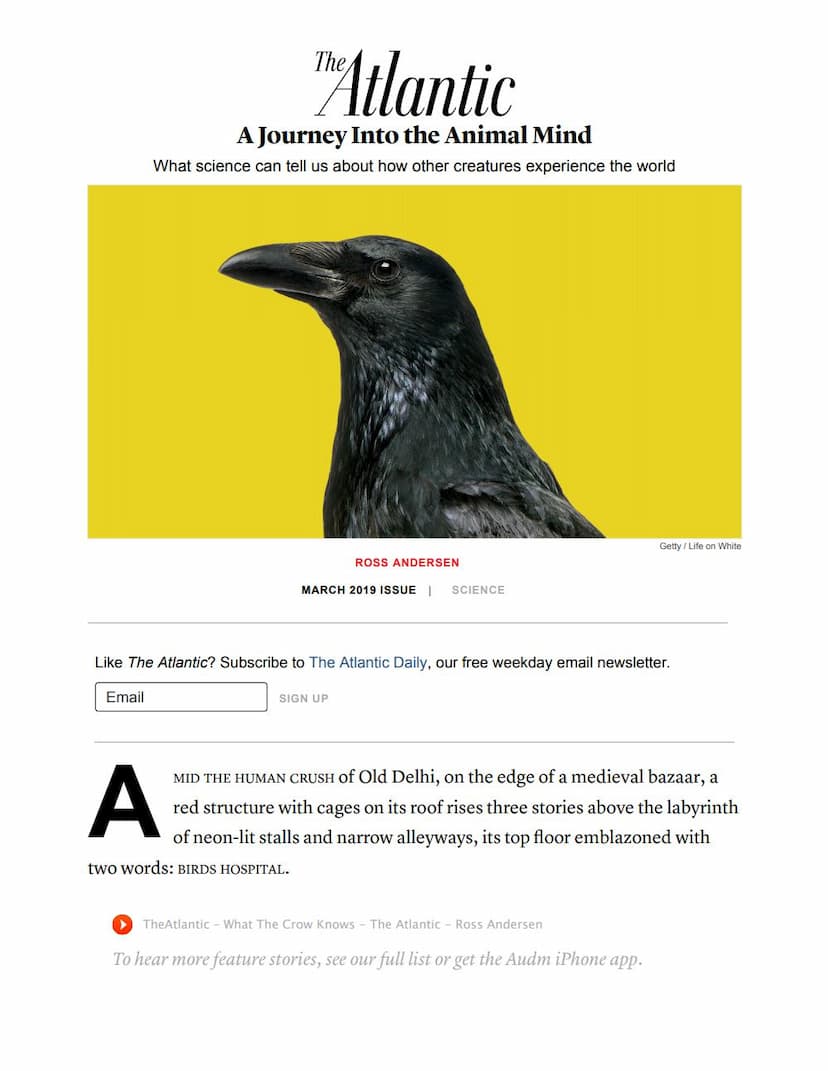Journey Into The Animal Mind
Added to library: September 2, 2025

Summary
Here's a comprehensive summary of Ross Andersen's article "A Journey Into the Animal Mind," published in The Atlantic in March 2019, focusing on its exploration of animal consciousness through the lens of Jainism and scientific research:
The article "A Journey Into the Animal Mind" by Ross Andersen explores the complex and evolving understanding of animal consciousness, drawing a significant parallel between modern scientific findings and the ancient ethical framework of Jainism. Andersen's journey takes him to India, where he witnesses the practical application of Jain principles at a bird hospital in Old Delhi and later to a Jain pilgrimage site on Girnar mountain.
Jainism's Ethical Foundation for Animal Consciousness: Andersen introduces Jainism as an ancient religion with a core commandment of ahimsa (non-violence) that extends not only to humans but also to all sentient beings, including animals. This deep-seated belief stems from the Jain conviction that animals are conscious beings capable of experiencing emotions like desire, fear, pain, sorrow, and joy. The article highlights the extreme measures some Jains take to uphold this principle, such as the bird hospital built by devotees, which treats injured and sick birds, and the monks' avoidance of root vegetables to protect subterranean ecosystems. He also mentions historical Jain influence on figures like Gandhi and their early advocacy for animal welfare laws.
The Scientific Frontier of Animal Consciousness: The article then shifts to the scientific perspective, noting a paradigm shift in research. The focus has moved from questioning if animals are conscious to understanding which animals are not. Andersen discusses how scientists are increasingly finding evidence of inner lives in a wide array of creatures, from primates and elephants to more "alien-seeming" beings like octopuses and crows. He touches upon the philosophical and scientific challenges of defining and measuring consciousness, acknowledging that while neuroscience can map brain activity, the subjective experience of consciousness remains a profound mystery.
Case Studies: Crows and Fish: The article uses specific examples to illustrate the complexities of animal cognition.
- Crows: Andersen observes an Indian crow at the bird hospital that exhibits seemingly intentional communication, making a special call for food and recognizing individual human faces. He discusses the crow's intelligence, demonstrated by tool use (shaping sticks into hooks, using traffic to crack walnuts) and passing the mirror test, which suggests self-awareness. The sophisticated social behaviors of corvids are compared to "feathered apes," hinting at a shared evolutionary path towards complex minds.
- Fish: The article then delves into the consciousness of fish, often underestimated due to their different environment and sensory systems. Andersen presents evidence of fish possessing rich memories, engaging in deceptive behaviors (female trout "faking orgasms"), and exhibiting cooperative hunting strategies with other species, suggesting a potential "theory of mind." The discussion also addresses the ethical implications of fish experiencing pain, detailing their responses to injury and the necessity of considering their subjective suffering.
The Jain Narrative of Neminath and the Path to Enlightenment: Andersen connects these scientific observations to Jain narratives. He recounts the story of Neminath, a Jain "Fordmaker" (a spiritual teacher) who renounced his worldly life upon hearing the screams of animals destined for his wedding feast. This story, set in the context of the Yamuna River, emphasizes the Jain commitment to compassion and spiritual awakening through the recognition of animal suffering. The pilgrimage to Girnar mountain, a sacred site for Jains, further illustrates this spiritual pursuit.
Girnar Mountain and the Symbolism of Enlightenment: The ascent of Girnar mountain serves as a metaphorical journey towards understanding. Andersen observes Jain monks and pilgrims, highlighting their disciplined lifestyles and their commitment to minimizing harm to all life forms. The encounter with a wasp on the trail prompts reflection on the ancient origins of consciousness and the potential for complex cognition to arise from diverse evolutionary paths. The article explores the idea that early consciousness might have been a simpler, more episodic experience compared to human consciousness.
The Temple of Neminath and the Future of Consciousness: Upon reaching the Jain temple at the summit of Girnar, Andersen witnesses a devotional ritual dedicated to Neminath. He reflects on the Jain belief that humans, in their natural state, are closest to experiencing universal consciousness, with access to the experiences of all sentient beings. The article concludes with a hopeful vision: that places like this temple, dedicated to figures who recognized animal consciousness, might become sites where humanity acknowledges its kinship with other minds, marking a significant evolution in human consciousness and our relationship with the natural world.
In essence, "A Journey Into the Animal Mind" argues that while science is progressively revealing the rich inner lives of animals, the ancient wisdom of Jainism offers a profound moral framework for interacting with these conscious beings, urging a deeper respect and compassion for all life.